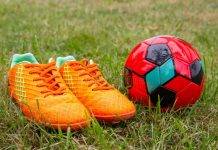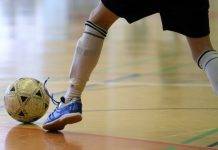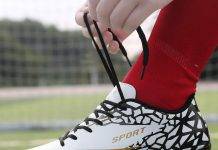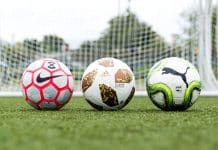Soccer and football are two popular sports that are played and loved by millions around the world. While both sports share similarities, one key difference lies in the equipment used, specifically the cleats.
Cleats are crucial in providing traction and grip on the field, enhancing player performance, and reducing the risk of injuries.
In this article, we will explore the main difference between soccer and football cleats, shedding light on why each sport requires a unique type of footwear to excel on the pitch.
So, whether you’re a soccer fan or a football enthusiast, understanding the distinction between these two types of cleats is essential to optimize your game.
Materials
Three primary materials are used to construct soccer and football cleats: leather, synthetic, and mesh. Each material has its advantages and disadvantages, so choosing the one that best suits your needs is important.
Review contents
Leather
Leather cleats are known for their durability and quality. They are often preferred by professional players for their longevity and comfort. Leather cleats tend to mold to the shape of your feet over time, providing a customized fit that enhances performance. Additionally, leather is a natural material that allows for better breathability, keeping your feet cool and dry during intense matches.
Synthetic
Synthetic cleats are made from various synthetic materials, such as polyurethane and leather. These cleats are often more affordable than their leather counterparts and can offer similar performance benefits.
Synthetic materials are also easier to clean and maintain, making them a practical choice for players who want cleats that require less upkeep. However, synthetic cleats may not provide the same level of breathability as leather cleats, so it’s essential to consider your comfort needs before making a decision.
Mesh
Mesh cleats are becoming increasingly popular among soccer and football players due to their lightweight design and superior breathability. Mesh materials offer excellent ventilation, allowing air to circulate inside the shoe and keeping your feet cool.
This can be particularly beneficial during hot summer games or in humid climates where excessive sweating is a concern. However, mesh cleats may not be as durable as leather or synthetic options, so they may not last as long under heavy usage. Consider your playing style and the conditions in which you’ll use the cleats to determine if mesh is the right choice.
Design
The design of soccer and football cleats plays a crucial role in performance and comfort. Each component of the cleat design contributes to different aspects of gameplay, so it’s essential to understand how they can impact your performance on the field.
Upper Design
The upper design of cleats refers to the material and construction of the top part of the shoe that covers the foot. This design can vary greatly depending on the brand and model of the cleat. Some cleats feature a seamless upper design, which reduces the risk of irritation and blisters. Others may have added features like ridges, textures, or padding in specific areas to enhance ball control and touch.
When choosing cleats, consider your playing style and position. For example, forward players may benefit from cleats with a more aggressive upper design that offers better grip and control when shooting or dribbling. At the same time, defenders may prioritize a cleat with additional protection and stability in the toe area to withstand tackles.
Outsole Design
The outsole design of cleats is crucial for grip and traction on the field. It consists of the bottom part of the shoe that makes contact with the ground. Cleats generally have studs or blades on the outsole to provide traction on various playing surfaces.
Football cleats typically have longer and more prominent studs to provide stability and traction on grass or turf. In contrast, soccer cleats have shorter and more numerous studs to allow for quick turns and agile movements on the field.
The outsole design should be selected based on the type of surface you primarily play on, as different stud configurations are optimized for different playing conditions.
Midsole Design
The midsole design of cleats refers to the layer between the outsole and the insole. It provides cushioning and support to absorb impact and reduce the risk of injuries. The midsole design can vary in thickness, density, and material, depending on the brand and model of the cleats.
Some cleats feature advanced cushioning technologies, such as foam or gel inserts, to enhance shock absorption and provide additional comfort during long matches. The midsole design should be chosen based on your preference for cushioning and support and any specific foot conditions or injuries you may have.
Lacing System
The lacing system of cleats may seem like a minor detail, but it can significantly impact overall comfort and fit. Cleats usually have a traditional lace-up design, but some models come with alternative lacing systems, such as Velcro straps or elastic bands.
The lacing system should allow for a secure and adjustable fit that keeps your feet stable inside the cleats during intense movements. It’s essential to ensure that the laces are not too loose, as this can lead to discomfort and instability or too tight, which can restrict blood flow and cause numbness.
Weight
The weight of cleats can significantly affect your performance on the field. Lighter cleats generally offer better speed and agility, while heavier cleats may provide more stability and durability. The choice between soccer and football cleats often depends on the specific weight preferences of the player.
Soccer Cleats
Cleats tend to be lighter in soccer, where speed and agility are crucial. The lighter weight allows players to move quickly, change direction rapidly, and perform complex footwork efficiently. This is especially important for forwards and midfielders, who rely on speed and quickness to outmaneuver opponents.
Lightweight soccer cleats are usually made with synthetic leather and mesh materials to reduce unnecessary weight. They often have a minimalistic design and may feature cutouts or perforations in the upper to further decrease the overall weight of the cleats.
Football Cleats
Football cleats, on the other hand, typically have a slightly heavier construction to provide additional stability and support. The nature of the game requires frequent tackles and abrupt changes in direction, which can strain the feet and ankles significantly. Heavier football cleats with more substantial midsole cushioning and ankle support can help absorb impact and mitigate the risk of injuries.
Football cleats are designed to prioritize protection and durability over speed and agility. They often have a sturdier outsole with longer studs for better traction on grass or turf and a more robust upper design to withstand the game’s physical demands.
Grip and Traction
Grip and traction are of utmost importance in soccer and football, as they can significantly impact your ability to stay balanced, make quick movements, and maintain control over the ball.
Studs
The most significant factor determining the grip and traction of cleats is the design and configuration of the studs on the outsole. Studs come in various shapes and sizes, each offering different benefits depending on the playing surface.
Soccer cleats often feature conical or bladed studs that are shorter and more numerous. This design allows for better grip and quick turns on grass or artificial turf. The diversity of studs spreads the player’s weight evenly across the foot, providing stability and minimizing the risk of slipping.
On the other hand, football cleats usually have longer and more prominent studs that are often triangular or rectangular. These studs are optimized for gripping natural grass surfaces, providing traction, and preventing the cleats from sinking into the ground during aggressive movements. The longer studs offer better stability and traction during tackles and sudden changes in direction.
Pattern
In addition to the shape and length of the studs, the pattern in which they are arranged on the outsole also affects the grip and traction of cleats. The pattern can vary from brand to brand, with some cleats featuring a mix of different stud configurations to optimize performance on various playing surfaces.
Soccer cleats may have a combination of bladed, conical, and chevron-shaped studs arranged in a way that enhances grip and stability during sharp cuts and turns. The pattern aims to provide multidirectional traction, allowing players to maneuver with agility and maintain control over the ball.
Football cleats often have a more straightforward pattern, with larger and more widely spaced studs arranged symmetrically. This design allows for optimal grip and push-off power on grass or turf, allowing players to accelerate quickly and make explosive movements.
Count
The number of studs on the outsole can also impact grip and traction. Cleats with more studs provide better overall stability and balance by distributing weight evenly across the foot. However, more studs can also increase the risk of mud or turf buildup, which may hinder the cleats’ performance.
Soccer cleats typically have a higher stud count, ranging from 10 to 14. This abundance of studs allows for improved traction and grip on varying playing surfaces, making soccer cleats versatile for different field conditions.
Football cleats generally have fewer studs, ranging from 6 to 8, as the larger and more widely spaced studs provide sufficient grip and traction on grass or turf. This reduced stud count prevents excessive mud accumulation and allows for easier cleaning and maintenance.
Support and Stability
Support and stability are essential when choosing soccer or football cleats. The proper support can help prevent injuries and enhance your performance on the field.
Ankle Support
Ankle support is crucial in soccer and football, as ankle injuries are common due to the nature of the sports. Cleats with good ankle support can help stabilize the ankle joint, reducing the risk of sprains and twists.
Soccer cleats typically have a lower-cut design, providing more freedom of movement and agility. While this may offer less ankle support than higher-cut cleats, it allows for better maneuverability and faster footwork. Some soccer cleat models offer extended ankle collars or built-in ankle straps for added stability if you have a history of ankle injuries or require additional ankle support.
Football cleats, on the other hand, often feature a higher-cut design that wraps around the ankle. This provides more support and prevents excessive ankle rolling during tackles and changes in direction. The higher cut protects against potential injuries from contact with other players’ cleats.
Heel Support
Heel support is essential for stability and balance during running, jumping, and cutting movements. Proper heel support can prevent heel slippage inside the cleats, ensuring a secure fit and minimizing the risk of blisters or discomfort.
Both soccer and football cleats typically feature a sturdy heel counter, a reinforced material at the back of the shoe that wraps around the heel. This helps lock the heel and prevents excessive movement inside the cleats. Look for cleats with a well-padded and contoured heel counter to ensure optimal comfort and support.
Arch Support
Arch support plays a significant role in distributing weight and reducing strain on the feet during gameplay. Cleats with proper arch support can help alleviate discomfort and fatigue, allowing you to perform at your best for extended periods.
Soccer and football cleats usually have moderate arch support built into the midsole design. This support balances comfort and flexibility, as excessive arch support can hinder natural foot movements. However, if you have specific arch support needs or preexisting foot conditions, consider purchasing cleats that allow customization or are compatible with aftermarket insoles.
Flexibility
The flexibility of cleats is crucial for natural foot movements, agility, and quick acceleration. The right amount of flexibility can enhance performance and prevent discomfort or injuries.
Soccer Cleats
Soccer cleats are generally designed to be more flexible compared to football cleats. This flexibility allows for better ball control, quick changes in direction, and fluid footwork. Soccer players often require cleats that mimic the foot’s natural movements, enhancing their ability to perform intricate dribbling and shooting techniques.
Soccer cleats often have a more minimalistic construction with thinner and pliable upper materials. This allows for a more excellent range of motion and a closer feel to the ball, promoting better touch and control. The midsole design of soccer cleats is also typically softer and more flexible to facilitate natural foot movements during gameplay.
Football Cleats
Although designed to provide stability and protection, football cleats still offer a certain level of flexibility. However, compared to soccer cleats, they tend to prioritize structural integrity and support over flexibility. The nature of the game requires frequent high-impact movements and tackles, which place additional stress on the feet and ankles.
Football cleats often have more reinforced upper materials, such as synthetic leather or thicker fabrics, to provide extra support and protection. The midsole design may also be stiffer to prevent excessive foot movements and maintain stability during rapid direction changes or heavy impacts.
Balancing flexibility and support that suits your playing style and individual preference is essential. Too rigid cleats may restrict movements and hinder performance, while excessively flexible cleats may lack the necessary support and stability.
Comfort
Comfort is paramount when choosing the right cleats for soccer or football. Playing for extended periods requires cleats that provide adequate cushioning, breathability, and a secure fit.
Padding
Cleats with sufficient padding can help absorb impact, reduce pressure on the feet, and prevent discomfort or blisters. The padding is usually located where maximum support and cushioning are needed, such as the heel, collar, and tongue.
Look for soccer or football cleats with well-padded interiors that offer a plush feel and protect your feet from excessive friction. The padding should be firm enough to provide support and stability yet soft enough to ensure comfort throughout the game.
Breathability
Breathable cleats can improve comfort by allowing air circulation and preventing excessive sweating. When your feet are properly ventilated, you’ll experience less moisture buildup, which can cause discomfort and odor.
Soccer and football cleats may incorporate breathable materials, such as mesh panels or perforations, in the upper design to enhance ventilation. Mesh cleats, in particular, are known for their superior breathability, making them popular among players who prioritize comfort and moisture-wicking.
When selecting cleats, consider the environmental conditions you’ll be playing in. Cleats with enhanced breathability may be more suitable to keep your feet cool and dry if you often play in hot and humid climates.
Footbed
The cleats’ footbed, or insole, contributes to overall comfort and support. A suitable footbed should offer cushioning, arch support, and shock absorption to minimize the risk of foot fatigue and injuries.
Soccer and football cleats commonly come with removable footbeds, allowing you to customize the support and comfort according to your needs. If the stock footbed does not provide adequate cushioning or arch support, you can replace it with aftermarket insoles that offer a higher level of customization.
Pay attention to how the footbed feels under your feet when trying on cleats. It should provide a comfortable and supportive foundation for your foot, minimizing the risk of discomfort, foot strain, or injuries.
Durability
Durability is a crucial factor to consider when investing in soccer or football cleats. The right pair of cleats should withstand the rigors of regular practice and games, ensuring long-lasting performance and value for money.
Soccer Cleats
Soccer cleats are subjected to frequent running, kicking, and ball contact, which can stress the materials significantly. The durability of soccer cleats can vary depending on the brand, model, and materials used in their construction.
Leather cleats generally offer excellent durability due to the natural strength and resilience of the material. They can withstand repeated use and maintain their shape and performance over time. However, leather cleats may require more care and maintenance, such as regular cleaning and conditioning, to prolong their lifespan.
While typically not as durable as leather, synthetic and mesh cleats can still provide satisfactory longevity. Synthetic materials are often more resistant to wear and tear, while mesh offers a lightweight and breathable option. Consider your playing style and the frequency of use when assessing the durability of soccer cleats.
Football Cleats
Football cleats are designed to withstand high-impact movements, tackles, and aggressive play. As such, they are generally more durable compared to soccer cleats.
The upper materials of football cleats, typically synthetic leather or thicker fabrics, offer improved resistance to abrasions and tears. With longer and more robust studs, the outsole design is constructed to withstand the rigors of natural grass or turf play.
Football cleats are often subjected to harsher playing conditions, including rain, mud, and uneven ground. To ensure optimal durability, cleaning and maintaining football cleats regularly is essential, removing any debris or mud that may accumulate on the outsole or upper.
Price
The price of soccer and football cleats can vary significantly, depending on the brand, model, materials used, and additional features offered. It’s essential to consider your budget and specific playing needs when determining the proper price range for your cleats.
Soccer Cleats
Soccer cleats tend to have a wide price range, with options available for various budgets. Entry-level soccer cleats made from synthetic materials are often more affordable, making them a popular choice for novice players or those on a tight budget. These cleats can still offer adequate performance and durability but may lack some premium features in higher-end models.
Mid-range soccer cleats typically offer a balance between price and performance. They may include advanced technologies, premium materials, and enhanced support features that improve comfort and durability. These cleats suit players who want better performance without breaking the bank.
High-end soccer cleats, often worn by professional players, come with a higher price tag. These cleats are made from high-quality materials, incorporate the latest technologies, and offer superior performance benefits. They are designed to meet the specific demands of elite-level players and provide the utmost comfort, support, and durability.
Football Cleats
Football cleats also come at various prices, catering to different budgets and requirements. Entry-level football cleats are available at a more affordable price, typically constructed with synthetic materials that prioritize durability and protection. These cleats may lack some advanced features in higher-end models but still provide adequate performance for recreational or amateur players.
Mid-range football cleats strike a balance between price and performance. They often incorporate advanced cushioning and support features, premium upper materials, and optimized stud configurations for superior traction. These cleats suit players who want to improve comfort and performance without the premium price tag.
High-end football cleats are top-of-the-line models worn by professional and elite-level players. These cleats boast cutting-edge technologies, advanced materials, and meticulous attention to detail. They offer the ultimate performance benefits, including enhanced support, agility, and durability. However, they also come with a higher price tag, making them a significant investment for serious athletes.
Recommended Usage
The recommended usage for soccer and football cleats depends on the specific requirements of each sport and your playing style.
Soccer Cleats
Soccer cleats are specifically designed for the game of soccer, offering features that cater to the sport’s unique demands. They are suitable for various playing surfaces, including natural grass, artificial turf, and indoor courts. Soccer cleats excel in providing traction, ball control, agility, and quick movements on the field.
Whether you’re a beginner or a professional player, soccer cleats are a must-have for anyone serious about excelling in the sport. They are versatile and can accommodate various positions and playing styles. From forwards requiring excellent grip and shooting accuracy to midfielders requiring agility and precise passing, soccer cleats are designed to enhance performance and help you make the most of your abilities on the pitch.
Football Cleats
Football cleats are designed specifically for American football, which involves high-impact plays, rapid changes in direction, and aggressive movements. They are optimized to provide stability, traction, and protection on natural grass and turf surfaces.
Football cleats are essential for participating in organized football leagues or participating in recreational games. They offer superior support, cushioning, and durability, helping reduce the risk of foot and ankle injuries common in the sport. The longer studs on football cleats provide better traction, allowing players to make explosive movements, maintain balance, and withstand the game’s physical demands.
Whether you play as a quarterback, receiver, lineman, or any other position, football cleats are designed to enhance your performance and ensure that you have the support and stability you need to excel in the sport.
In conclusion, while soccer and football cleats share some similarities in design and functionality, key differences make each type suitable for its respective sport. By understanding the materials, design elements, support features, and recommended usage of soccer and football cleats, you can make an informed decision and find the perfect pair of cleats that will help elevate your game and maximize your performance on the field.










































